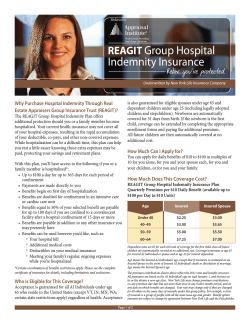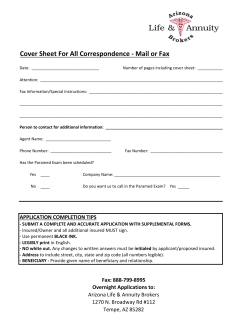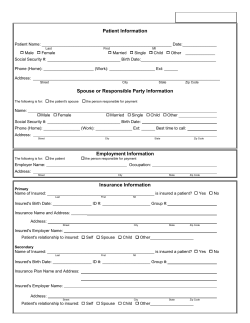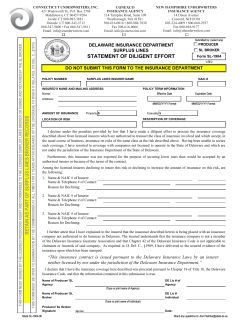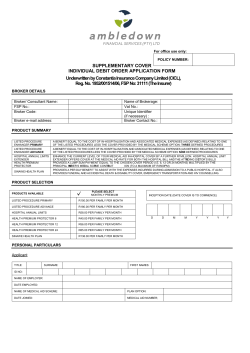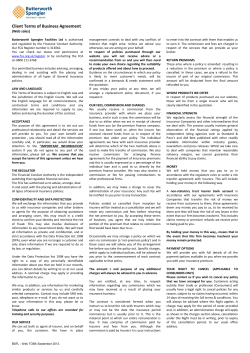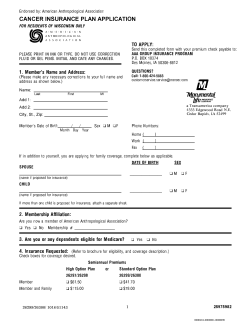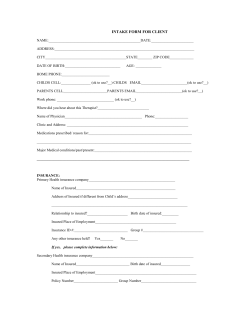
SLOAN RISK MANAGEMENT SERVICES LIMITED
SLOAN RISK MANAGEMENT SERVICES LIMITED RISK MANAGEMENT AND INSURANCE CONSULTANTS Telephone 64 4 472 6896 Facsimile 64 4 471 1240 E-mail sloanrisk@xtra.co.nz Website: www.sloanrisk.co.nz P.O. BOX 10173 WELLINGTON NEW ZEALAND RISK MANAGEMENT NEWSLETTER NO. 210 This newsletter is downloadable from our website insurance premium is more than the value of his car!" Circulate to: • Finance • Property • Insurance • Procurement • Legal ”He has discovered that his INSURANCE TRIVIA Question: Answer: Which type of insurance policy can exclude cannibalism? Aqua-culture policies (i.e. insurance of live fish mortality). COLLABORATIVE INSURANCE PROCUREMENT This approach is recognised overseas especially in Australia with their ComCover and State Self Insured Funds reinforced by reinsurance. Our own Government is now proceeding with the initial stages of an All of Government insurance. The potential benefits are obvious as are the complications. PROPERTY INSURANCE INDEMNITY VALUE COVER OPTION REMAINS VALID A recent audit revealed that the client had been forced to acquire and insure a large building which was unwanted but continued to be insured for its full replacement value. On reviewing the matter it was confirmed the building was totally superfluous and, if a total loss, would not be rebuilt at all. So indemnity value cover was costed and the annual premium cut in half. The “dangers” of indemnity value insurance were recognised especially: For a partial loss, insurers could deduct an amount for repairing or replacing “new for old” which is usually termed “betterment”. _______________________________________________________________________________________ PRINCIPAL – JOHN SLOAN, A.N.Z.I.F. (FELLOW) A.R.M. OFFICE –2nd Floor, Aviation House, 12 Johnston Street, Wellington, N.Z. TELEPHONE – (Mobile) 027 4461 728 / (Private 64 4) 232 4241 2 In event of a total loss the indemnity value is all they would get. The indemnity value needed to be correctly established (in this case it was). The insurers had to agree first as some will not grant full business interruption cover on buildings insured for indemnity value alone. Financiers had to agree as any loan/mortgage may require full replacement value insurance irrespective of the client’s view. READ THE POLICY In another case, one policy excluded earthquake cover. This really surprised the broker, who had just taken over the programme, but obviously, hadn’t read the policy exclusions. BUSINESS INTERRUPTION INSURANCE ... SAME OLD PROBLEMS EXIST Yet again: Claims preparation costs seriously under insured. Standard limits in Package/Scheme Policies can be far too low for some businesses. Check all sources of income to ascertain which would continue unabated after an insured interruption (such as share investment income) and not need insurance and those which would definitely reduce. Rental income can create complications. Reliance on just one nationwide distribution centre which obtains all its products from China but that dependency is not included in the business interruption policy ... which is not unusual. Remote “hot site” getting established for the computer facility but no advance thought for the insurance changes required or the provider’s insurance or liability restrictions. Wages/salaries over insured when more cost effective and appropriate options were available. CONTRACT WORKS INSURANCE LIMITS As virtually all Property policies exclude separate Contract Works/Alterations to insured buildings separate cover is required. This is because the risk is increased. Most businesses have their Property policies extended to automatically cover Contract Works up to an agreed limit to ensure multiple small contracts are insured but contracts over the pre agreed limit are not covered at all. In such cases the contractor can insure them or the client. The real danger is, and this has emerged with devastating consequences for some entities, is that a building/alteration/refurbishment/new building on site contract in excess of the policy limit is completed, and commenced, with no insurance cover at all in place by the client or contractor. Another problem is that when a building is insured by a contractor and is completed the client’s Property policy is meant to take over. Again incidents occur when this does not happen and the building/property is not insured at all. If a policy is on specific declared assets and not blanket on a basis a costly uninsured claim can occur. This happened once or twice in the Canterbury earthquakes. JEWELLERY VALUATIONS OVERSTATED We were recently asked to comment on a claim where a woman lost her engagement ring. It had been specially made by a friend who was a jeweller for $12,000. She was told it would retail at $21,000 and was specifically insured for that amount. However when she claimed, the insurers said that “their” jeweller would replicate it for $12,000 and that is all they would pay to meet their obligation to “replace” it. Her friend said he would do the same, so she took the cash settlement but complained about paying a premium on $21,000. The insurers did not see the irony of them telling her that their proposed new ring, costing $12,000 would have an insurable value of $20,000! NL #210 3 People should not readily believe the inflated “shop valuations” given to them after purchasing jewellery which are a ploy to imply they got a bargain when buying it for much less. Independent, professional valuations are preferable. CHECK OUT NEED FOR DIRECTORS AND OFFICERS LIABILITY COVERAGE We were involved in a review which revealed that, possibly, an unnecessary D & O policy was affected. The matter arose out of reviewing insurances for a subsidiary organisation. The parent company had a separate D & O policy which also applied to all of the subsidiaries. However, independently, the subsidiary had also taken out a D & O policy including protection for the self same directors who were covered under the parent’s D & O policy. Note also that D & O Policies traditionally exclude: Intentional Acts. Professional Liabilities (separately insurable if an exposure). Inadequate insurance arrangements; eg. a D & O Policy does not pick up major underinsurance or non-insurance of valuable property due to the negligence or oversight of either management or even the directors. BROKER SELECTION PROCESS In 1996 the Pittsburgh Chapter of the Risk Management Society produced a Best Practice publication that included a section on Ethics which continues to make valid points. Ethics Of major importance to this treatise is the issue of ethics. There has been no code of ethics accepted by the risk management profession as yet. The literature and anecdotes are rife with stories of unethical tactics used by both brokers and buyers in the selection process. We believe the following guidelines need to be considered as part of the selection process: 1. Friendship may provide access, but should not have any impact on the actual selection. 2. Gifts of a material nature must be declined if there is any possibility (real or perceived) of their having impact on the selection process. 3. Quotes or information from one broker must not be shared with another prior to the selection. After the selection process is concluded, you many share the proposal as a method of contrasting their quality and/or content with the other broker’s. 4. A broker selection process should not be used to replace an incumbent, hoping that the incumbent will not be successful. If the incumbent is not performing satisfactorily, the proper action is to correct the situation. If correction is not achieved or there is no improvement, the incumbent should not be included in the selection process. 5. The broker selection process should not be used to ratify a decision already made (i.e. the desire that one broker, perhaps the incumbent, be the winner and the selection process is “rigged” so the decision is validated). Competition for accounts in expensive for the participants and it is not ethical to use brokers in this way. 6. The servicing team at the brokerage firm must participate in preparation of the response to the RFP and be involved in the oral presentation. This will assure the prospective buyer the broker is prepared to service the account. 7. Further, “blue skying” or presenting unattainable program structures in conceptual presentation, when the broker knows the programs are not achievable, is not acceptable. 8. Low balling first-year brokerage fees with the clear intent of buying the business can be countered by requiring multi-year caps on fees and multi-year policies where available. NL #210 4 HOUSES/FLATS/APARTMENTS RENTED OUT AT RISK IF NOT REGULARLY INSPECTED Some landlords may not be fully aware of major insurers’ requirements for the rented out properties to be regularly inspected. One major insurer’s House policy contains the following Condition which goes beyond just inspections. Any breach could void an insurance claim where the specific requirements become material and can apply to both the owner and any property manager. LANDLORD’S OBLIGATIONS You, or the person who manages the tenancy on your behalf, must: 1. Exercise reasonable care in the selection of tenant(s) by at least obtaining satisfactory written or verbal references, and 2. Collect: a. At least 1 week’s rent in advance, and b. At least 2 week’s rent in the form of a bond that will be registered with Tenancy Services, or c. Any combinations of (a) and (b) to a total of 3 weeks’ rent, and 3. Complete an internal and external inspection of the property at a minimum of 4 monthly intervals and upon every change of tenant(s), and 4. Keep a written record of the outcome of each inspection, and provide us a copy of the record if we request it, and 5. Monitor rents on a daily basis with written notification being sent to the tenant(s) when the rent is 10 days in arrears. If rent is not received then a second letter must be personally delivered to the tenant(s), at which point in time it must be ascertained whether or not the tenant(s) is/are currently in residence and 6. Make application to the Tenancy Tribunal for vacant possession in accordance with the provisions of the Residential Tenancies Act 1986 once the rent is 21 days in arrears. EXTRACTS FROM OVERSEAS INSURANCE/RISK ARTICLES INTERNATIONAL United States: Financial Cost of Ebola Crisis Sparks Insurance Coverage Questions REINSURANCE Reinsurers must adapt to ‘new world of risk’ The reinsurance industry has been slow to respond to new risks because of its tendency to look to the past to predict the future, according to Brian Duperreault. The Hamilton Insurance Group chief executive officer, speaking yesterday at the opening of the Baden-Baden Reinsurance Symposium in Germany, added that reinsurers had new roles to play in a “new world of risk” – and opportunities existed for those prepared to take bold steps. LLOYD’S/U.K./EUROPE Risk responsibility lies with the board: Airmic welcomes Financial Reporting Council guidance Non-Life Insurers’ Profits Under Pressure Another significant trend revealed by the FERMA report is that insurance behaviours in Europe tend to depend on budget restraints and rules of thumb. “While tried and tested by many risk managers, this way of thinking could pose significant problems for the management of emerging risks such as cyber and environmental liabilities”. NL #210 5 Super distribution centres store up accumulation risk at one site trouble? CANADA Cyber-Risk – The Electronic Ebola of the 21st Century USA Insurer Warns About Ebola and Coverage A major insurer is warning customers it may impose restrictions on Ebola related liability claims for businesses and organisations with employees travelling to West Africa, in what is believed to be the first such move by the insurance industry as economic ripple effects of the deadly disease spread. Zurich based ACE Ltd., a leading global property and casualty insurer, has begun selectively excluding Ebola from its coverage “on a case by case basis” for U.S. customers. BP Hopes Missing Comma in a Contract Triggers $750 Million Transocean Spill Insurance INSURANCE FACTORS IN MERGER AND ACQUISITION RISKS Some mergers and acquisitions go smoothly, whilst others create problems – the main insurance coverage issues can arise under the following: Accident Compensation – ACC claims experience of the company acquired can be incorporated into the experience of the parent with, possibly, a major impact on future levies. Residual Liabilities – These may be insured or self-insured by the company being taken over and need to be identified in advance because the new parent company will not be able to get insurance for existing known liabilities. Directors & Officers Liabilities – These create an equal minefield, if only because some D & O policies exclude coverage for the acts of a subsidiary company’s directors and officers that occurred prior to an acquisition date. Other problems arise in arranging run-off insurance and extended reporting period endorsement. Representations & Warranties – Where these are embedded in a company’s contracts it is not always possible for the new parent to avoid them. Personal Accident/Employee Benefits Insurances – In some cases, a company may have these types of policies included in their employment contracts, meaning they have to be continued by the parent company who may not even have the same types of coverage themselves. Unpaid insurance claims. REMINDERS Property Policies normally contain an exclusion for “contamination” which can be applied to P Lab contamination of any property whether a home or a business. However some policies may include extremely limited cover but that is rare. Insurance agents (not brokers) invariably act for one insurer but some may have dual arrangements. The dangers of getting insurance premium quotations “on-line”, e.g. for travel: o Policy coverage may vary. o Some policies may contain major exclusions. o You don’t know the claims payment services or overseas resources. o The cheapest premium is not always the best – the premium may be cheaper because cover is limited compared to others. “Having a nice looking risk register is no guarantee a risk is being well managed” (Mathew Leitch). If you have to trim your insurance budget, do not cut back on essential protection by reducing cover at the higher levels, but consider self-insuring more at the bottom end, by accepting larger deductibles. This could have a bigger impact on premium savings, without exposing you to catastrophic losses. NL #210 6 ELABORATION OF OUR SERVICES EXISTING INSURANCE PROTECTION REVIEW AND SELF INSURANCE Organisations can be adequately insured, underinsured or over insured. A thorough review of the loss exposures and existing insurance protection will be made. More innovative solutions may be worth considering. Amalgamation or revision of policies can broaden cover, save costs or both. PREMIUM COST REVIEW – PREMIUM SAVINGS Insurance is a major expense for most organisations. A review of all insurance costs will be made to ensure premium rates are fair, competitive and allow all available discounts. In today’s economic climate, all organisations are reviewing costs, including insurance premiums and brokers’ remuneration. COMPETITIVE INSURANCE QUOTATION TENDERS – REVIEW BROKERS’ SERVICES Proper presentation of risks to the insurance market place has become increasingly important to the purchaser. We can analyse your risks, prepare comprehensive specifications for brokers to present to the insurance market and assist you in evaluating the resulting quotations. Our independence protects all parties involved and ensures a due diligence process. We have saved clients significant amounts of money with this service. SPECIALISED SERVICES: Claims audits or reviews Expert witness support Evaluation of third-party claim administrators Self-funding analysis or captive options Broker/agent review OUR ADDED VALUE We are well established and experienced in the insurance industry We have an enviable track record and client listing We concentrate on risk analysis and/or insurance consultancy assignments with no vested interests in any ultimate insurances which may be placed Fees are competitive, cost effective and agreed in advance. We do not operate on fees being a percentage of savings achieved, all of which go to the client. TERMS We can work on a fixed fee basis, by the project, or an hourly rate or on a retainer, depending upon the services you need, your objectives and your budget. We can provide a proposal for any service you may require at no cost or obligation, along with references. INDEPENDENT RISK MANAGEMENT AND INSURANCE CONSULTANTS Sloan Risk Management Services PO Box 10173, WELLINGTON Phone: (04) 472-6896 Fax: (04) 471-1240 Cell phone: (0274) 461 728 Email: sloanrisk@xtra.co.nz Website: www.sloanrisk.co.nz NOVEMBER 2014 MAILING LIST If any recipient of this newsletter wants to be deleted from the mailing list please email us. NL #210
© Copyright 2025
